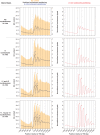DNA-guided establishment of nucleosome patterns within coding regions of a eukaryotic genome
- PMID: 26330564
- PMCID: PMC4617968
- DOI: 10.1101/gr.188516.114
DNA-guided establishment of nucleosome patterns within coding regions of a eukaryotic genome
Abstract
A conserved hallmark of eukaryotic chromatin architecture is the distinctive array of well-positioned nucleosomes downstream from transcription start sites (TSS). Recent studies indicate that trans-acting factors establish this stereotypical array. Here, we present the first genome-wide in vitro and in vivo nucleosome maps for the ciliate Tetrahymena thermophila. In contrast with previous studies in yeast, we find that the stereotypical nucleosome array is preserved in the in vitro reconstituted map, which is governed only by the DNA sequence preferences of nucleosomes. Remarkably, this average in vitro pattern arises from the presence of subsets of nucleosomes, rather than the whole array, in individual Tetrahymena genes. Variation in GC content contributes to the positioning of these sequence-directed nucleosomes and affects codon usage and amino acid composition in genes. Given that the AT-rich Tetrahymena genome is intrinsically unfavorable for nucleosome formation, we propose that these "seed" nucleosomes--together with trans-acting factors--may facilitate the establishment of nucleosome arrays within genes in vivo, while minimizing changes to the underlying coding sequences.
© 2015 Beh et al.; Published by Cold Spring Harbor Laboratory Press.
Figures





References
-
- Chen X, Chen Z, Chen H, Su Z, Yang J, Lin F, Shi S, He X. 2012. Nucleosomes suppress spontaneous mutations base-specifically in eukaryotes. Science 335: 1235–1238. - PubMed
Publication types
MeSH terms
Substances
Associated data
- Actions
Grants and funding
LinkOut - more resources
Full Text Sources
Other Literature Sources
Molecular Biology Databases
Miscellaneous
